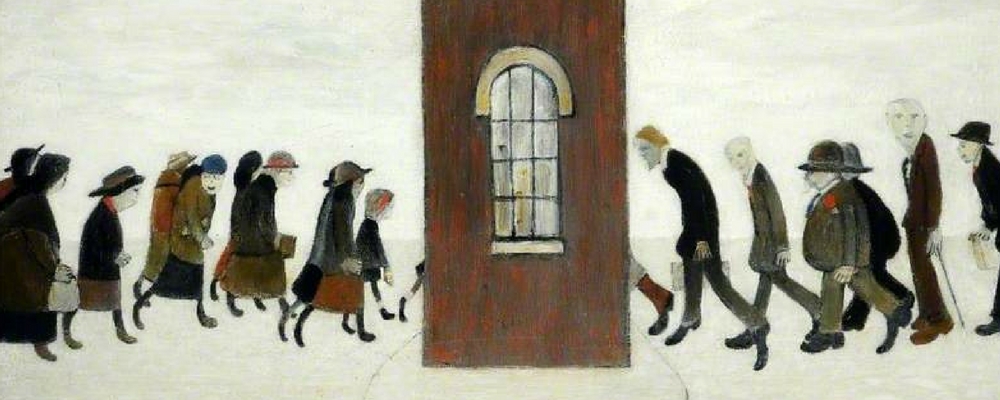
At Books@Work, we find books and short stories that generate meaningful discussion and encourage colleagues to share more of themselves. As one participant shared, a good book “makes it easier to break down people’s issues and have difficult conversations, because it’s hidden behind the cloak of the material.”
For many groups, a “good book” is a novel with dynamic characters and ethical dilemmas. For others, it might be a nonfiction narrative like Margot Lee Shetterly’s Hidden Figures, which often resonates with engineers and manufacturing employees. But some books, like James McBride’s memoir The Color of Water, find success and provoke powerful discussions with groups across the board.
What is the book about?
Read More

He died almost 100 years ago, but Franz Kafka’s voice remains oddly relevant today. He wrote such bizarre and affecting stories that he left behind his own adjective, “kafkaesque”, to describe strange and nightmarish situations embedded in everyday life. With no shortage of the strange these days, we were particularly excited to have Books@Work featured in The New York Times – comparing Kafka’s iconic book, The Metamorphosis, with an powerful article on social isolation and loneliness, written by Dhruv Khullar, a physician and professor of healthcare policy at Columbia University.
Kafka’s stories feature disaffected characters who push the edges of the human condition – and often fail. The Metamorphosis is no exception. Traveling salesman Gregor Samsa wakes one morning to find that he has been transformed into a hideous bug. Unable to communicate, Gregor finds his sense of self and his relationship to his family and his work irreparably destroyed, with dire consequences.
Read More

As modern companies focus on systems, outcomes and corporate accountability, creativity remains elusive. But innovative companies want creative teams. Although we live in a culture that firmly separates work from play, current neuroscience research requires us to take a second look. Stepping back from work – partaking in playful engagement or exploration – is essential to innovative thinking, energy, empathy, individuality – and to our very nature as human beings.
Recently, I discovered that digital gamers embrace a classic book about play called Homo Ludens: A Study of the Play-Element in Culture (1938) by Dutch philosopher Johan Huizinga. Huizinga says that play is at the center of everything in human culture, and that it happens within what he called a magic circle. Although Huizinga could not have imagined the world of digital games, he described the magic circle as a temporary world within the ordinary world where people play by special rules and engage in pleasurable activities that ignite the imagination.
Read More

I was stunned recently when a group of Books@Work participants zeroed in on love as a core theme in a story. The setting was powerful: a group of police officers, police academy cadets and city residents meeting in an urban day care center to discuss Langston Hughes’ story, “Thank you Ma’am.” The story centers on Luella, a large woman and a “force to be reckoned with”, who overpowers a young boy when he tries to steal her handbag. She drags him home (literally), cleans him up, feeds him, listens to him and sends him home with an experience far greater than the one he bargained for!
In short, the participants said, she showed him love. Tough love. “We have co-opted love to mean only eros,” said one participant, “but love is the most powerful force. Love grabs us by the throat,” but upholds dignity and respect and allows us to retain our voices.
Love has a long and storied history – and it’s complex. The ancient Greeks had at least four distinct words for love: Philia (fraternal love), Storge (familial love), Eros (erotic love but also the love of beauty) and Agape (divine or compassionate love). But what’s love got to do with work?
Read More

When Apple CEO Tim Cook appeared on NPR’s Morning Edition in June, interviewer Steve Inskeep posed a question about the uncertain future of artificial intelligence in the workplace: “Are you. . . scared by the prospects of AI getting out of control?”
“I don’t really worry about machines thinking like people,” Cook replied. “I worry about people thinking like machines.” The real cause for concern, he added, is the potential “absence of humanity” and “deep thought” in the corporate world.
Cook’s response immediately reminded me of Ken Liu’s “The Regular,” a short story that we have used in Books@Work programs and discussed together as a team. The premise is simple: police detectives in a not-so-distant future have been outfitted with devices that regulate their decision-making functions. If the regulator detects too much emotion behind a decision, it will nudge the brain to be more logical, no matter the consequences. In other words, what happens when people think like machines?
Read More

We are more than five years into the Books@Work journey and we learn so much from our participants, professors and partners as they share their personal and collective experiences with the program. But as we shape and evolve the program, certain themes persist – as if to remind us of how far we have come and how far we still have to go. We wrestle with one such theme often as we offer new books and stories to teams and groups: whether “liking” or “disliking” a particular text affects its ability to generate and support a rich and engaging discussion. In exploring this idea, we return to a post I wrote a few years ago on this very topic. In short, we at Books@Work want all of our participants to be enriched, inspired and transformed by a text and, more importantly, the discussion. We continue to believe that there are boundless learning opportunities in each and every text – even when it’s not your cup of tea.
Read More

As is my custom, I recently devoured a new podcast from Gimlet Media called The Habitat during a long and un-airconditioned road trip to Florida.
The Habitat follows a simulated mission-to-Mars research project called HI-SEAS. As space travel to Mars becomes more likely, researchers are tasked with perfecting equipment like “the dome,” a semi-portable living structure about the size of a two-car garage that would house six astronauts. But HI-SEAS is designed to test “a far more critical piece of equipment: humans.”
For a year, six “human guinea pigs” agree to spend every waking and sleeping moment together in a dome on a Hawaiian volcano, a stand-in for the red planet. HI-SEAS seeks to determine what these conditions will do to their astronauts. Poring through 200 hours of the crew’s audio diaries, The Habitat host Lyn Levy shadows the experiment from day one. “It’s like the premise of a space age reality show,” she says.
Read More

Books@Work participants tell us over and over that the sessions are a “great way to get to know your colleagues, your peers, on a totally different level” as well as “de-stress.” They highlight that the program “brings us all together in a different way.” Because I have such a varied work history – in food service, office jobs, caring for handicapped adults – I resonate with our participants when they tell us how valuable getting to know your colleagues is and how they look forward to moments of refreshment in the midst of a busy and demanding day.
Because of this, it has been a special pleasure to participate in Books@Work myself. I first participated in 2014, with the classified staff of a Cleveland-area school. I was struck by how, at first, it was difficult for people to express their thoughts. It seemed like they were all searching for a “right” answer and participants were hesitant to hazard their opinion. But after a few weeks, people started to trust that they had something meaningful to say and that the group was interested in their ideas. After people found their voices, the conversations became more engaging. When we read John Steinbeck’s “The Chrysanthemums,” we disagreed about our interpretations, and some people told really personal stories. In the end we respected the unique perspective of each person in the room. The opportunity to share and reflect gave those staff members a chance to see each other as people instead of a job title, like bus driver or teacher’s aide.
Knowing the benefits, why not participate in Books@Work as a staff?
Read More

In the wake of the #MeToo movement, a flood of women have come forward to shed light on another serious challenge they face at work: the “boys’ club” culture that exists across many industries. It permeates traders in the stock market, chefs in the restaurant industry and programmers in Silicon Valley. It’s in the advertising industry, where 180 female executives have launched a new initiative to bridge a glaring gender gap. And it’s in the music industry, where one female songwriter says that opportunities for women to develop are few and far between.
Recently at the 90th Academy Awards, Best Actress winner Frances McDormand concluded her acceptance speech with a directive for Hollywood executives: “I have two words to leave with you tonight, ladies and gentlemen: inclusion rider.” Hiring more women is a crucial first step. But the authentic inclusion of women necessitates taking a hard look at a general corporate culture that makes 81% of women feel some form of exclusion at work.
Read More









